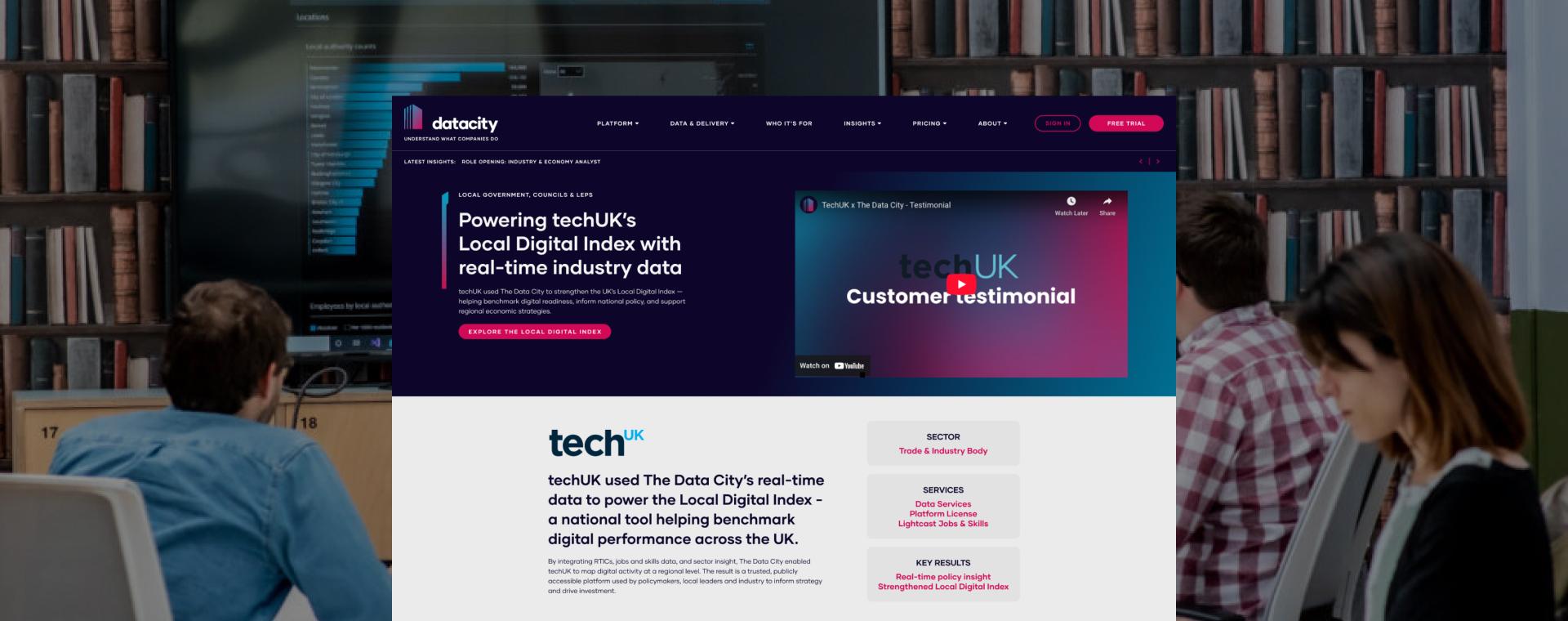Rebuilding The Data City’s site around real people, not just pages
Designing a website that reflects how users think, decide and explore.

The Problem
An ambitious data company with growing audiences and no shared framework for understanding them.
The Data City is trusted by governments, fintechs and researchers for real-time insight into UK industry, but their website didn’t fully reflect that clarity or credibility.
Internally, individual team members had a wealth of knowledge about who their users were. But these audiences hadn’t been formally documented or categorised in a way that the wider team, or external consultants, could reference. There were no clear archetypes or agreed segmentation to inform design, messaging or content strategy.
This gap led to inconsistent decisions and misalignment:
- Users landed on a site, rich in information, but overwhelming to navigate and struggled to understand where they fit or what to explore
- Sales and marketing teams spent time clarifying what The Data City offers, rather than focusing on value.
- Editors were stuck managing growing volumes of disconnected pages, with no structured way to surface the right content in the right places
- Case studies, reports and testimonials existed - but were hard-coded, siloed and difficult to tailor to individual audience groups
The business had evolved, expanding into new sectors, markets and delivery models but the site’s architecture, navigation and content model hadn’t caught up. The Data City needed a system that was user-first, scalable and strategically grounded.
The Process
A complete audit of audience, structure and content built on real user needs.
We began with a series of workshops to define and document the audience, resulting in the identification of six archetypes and their accompanying empathy maps. These archetypes gave the team shared language, sharper focus and a usable foundation for UX and marketing decisions.
We then tackled the site’s structure. Working across IA, content modelling and design, we:
- Reorganised the navigation around the archetypes intent and information-seeking behaviour
- Re-designed the site’s mega menu to let users self-identify and browse by task or sector
- Restructured key page types to align with archetype needs and mental models
- Created base templates for product pages, case studies, sector landing pages and reports, focused on outcomes rather than internal labels
- Migrated key content types into custom post types: Case Studies, Reports, Testimonials, Clients and Products
- Introduced sitewide taxonomies for Sector, Product, Topic, Region and Archetype - enabling dynamic relationships and smarter content surfacing
Everything was mapped back to the archetypes. Content became structured, relationships became automated, and journeys became coherent, all without adding complexity for the team.
The Solution
Information architecture built around real users, and a content system that works for the team.
The updated navigation gives each audience type a clear, relevant starting point. Key pages focus on outcomes rather than features, helping users understand what The Data City can help them achieve.
Case studies, reports and testimonials are now surfaced dynamically based on sector or topic, making them easier to find and keep up to date. Instead of being manually added in isolated pages, they’re part of a structured system that allows content to support decision-making wherever it’s needed.
For users:
- They can now find content relevant to their sector or need in the first interaction
- They get proof, credibility and guidance without pressure
- They engage with the content that fits their context, without guessing
For the internal team:
- Sales conversations start further down the funnel with users who already understand the value
- Marketing has a framework to target, write and publish for specific audiences
- Content management is simpler dynamic relationships replace manual and repetitive input
- The whole site is easier to scale across sectors, regions or services
This wasn’t just a navigation refresh. It was a huge step forward in the way The Data City structures, surfaces and shares its products and services - giving users clarity, and the team control.
